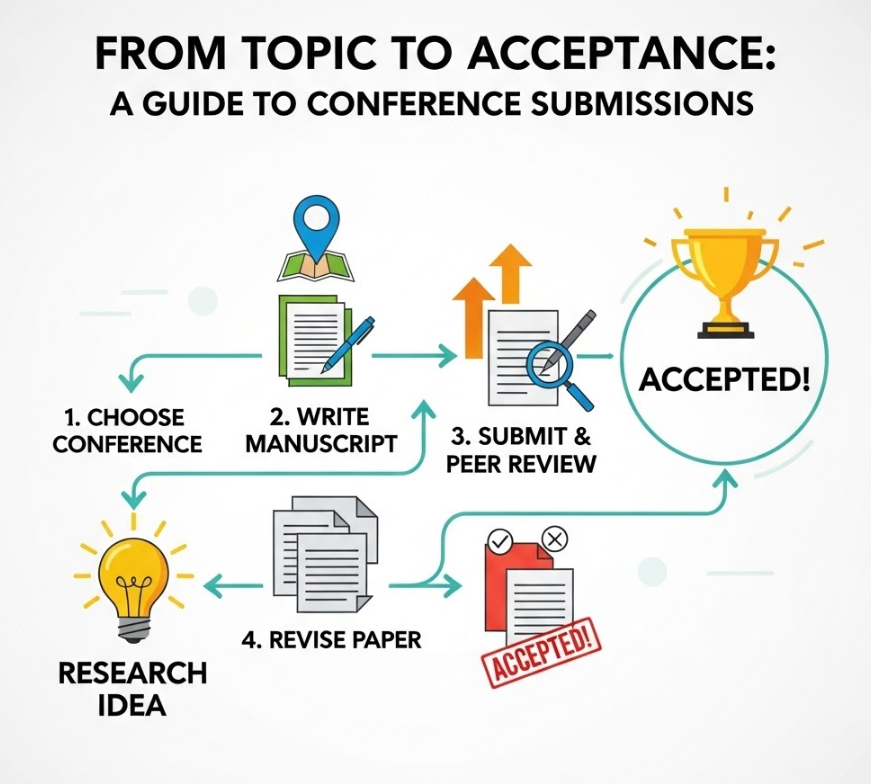

69 views||Release time: Oct 13, 2025
For any researcher, the journey from a nascent idea to a paper accepted at a prestigious academic conference is both challenging and rewarding. It's a process that requires more than just good research; it demands strategic planning, meticulous writing, and a deep understanding of the academic publishing ecosystem.
This "complete guide" demystifies the process, breaking it down into clear, actionable steps. Whether you are a PhD student preparing your first submission or a seasoned academic aiming for a top-tier conference, this guide will walk you through every step to maximize your chances of success.

Long before you write a single word of your paper, you must lay the strategic groundwork.
Identify a Conference-Worthy Contribution: Not all research is ready for a conference. A good conference paper needs a focused, novel contribution that can be clearly communicated. Ask yourself: What is the single, most interesting finding or new technique from my recent work? Can it stand alone as a coherent story?
Choose the Right Conference: Submitting to the wrong conference is the most common reason for desk rejection.
Analyze the Call for Papers (CFP): Read the conference's themes and scope with a critical eye. Does your work perfectly align with one of the tracks?
Assess the Prestige: Is this a top-tier "flagship" conference or a smaller, more focused workshop? Match the novelty of your work to the prestige of the venue.
Check the Publisher and Indexing: Will the proceedings be published by a reputable press (e.g., IEEE, ACM, Springer) and indexed in major databases like Scopus or EI Compendex?
Work Backwards from the Deadline: Find the submission deadline and create a realistic timeline for writing, getting feedback, and revising. (Current Date: Monday, October 13, 2025. Many deadlines for mid-2026 conferences are in the next 3-4 months, so planning should start now.)
This is where your research takes shape as a compelling narrative.
Craft a Powerful Abstract: The abstract is your paper's advertisement. In about 250 words, it must summarize the problem, your method, your key results, and your main conclusion. Write and rewrite it until it is perfect.
Build a Strong Introduction: This is the most important section for hooking your reviewers. It must clearly:
Introduce the broad problem area.
Summarize the state-of-the-art and identify the research gap.
State your research question or hypothesis.
Explicitly list your novel contributions.
Follow the IMRaD Structure: For most scientific and technical fields, structure your paper logically: Introduction, Methods, Results, and Discussion. This familiar structure makes your paper easy for reviewers to follow.
Show, Don't Just Tell: In your Results section, use high-quality figures, graphs, and tables to present your findings clearly. A well-designed visual is often more powerful than a paragraph of text.
Write a Thoughtful Discussion: Don't just restate your results. Interpret what they mean, connect them back to your research question and the literature, and honestly discuss the limitations of your work.
A polished submission signals professionalism and respect for the review process.
Strictly Adhere to Formatting: Download the official conference template (LaTeX or Word) and do not deviate from it. Check the page limit, font sizes, margins, and reference style.
Meticulously Proofread: Typos and grammatical errors create a poor impression. Use grammar-checking software, read your paper aloud, and, most importantly, have a colleague or mentor proofread it one last time.
Anonymize If Required: For double-blind conferences, you must remove all identifying information (author names, affiliations, self-citations). Check the guidelines carefully.
Submit Early: Don't wait until the last hour. Submission portals can get overloaded, and you may need time to deal with unexpected formatting issues.
Navigate the Review: After a few months, you will receive one of three decisions: Accept, Reject, or Revisions Required. A "Major Revisions" decision is a positive outcome—it means the reviewers are interested!
Write a Persuasive Rebuttal: If you are asked to revise your paper, you must write a "Response to Reviewers" letter. Address every single comment systematically and politely, explaining how you have improved the manuscript based on the feedback.
Congratulations! Once your paper is accepted, you're on the home stretch.
Prepare the Camera-Ready Version: This is the final, polished manuscript for publication. Incorporate the last round of feedback and use the publisher's tools (like IEEE PDF eXpress) to ensure it's compliant.
Register and Plan Your Trip: At least one author must register for the conference. Once registered, you will receive an invitation letter to apply for a visa (if needed) and can begin booking flights and accommodation.
Prepare Your Presentation: Whether it's an oral talk or a poster, start preparing early. Practice your presentation to ensure it is clear, engaging, and within the time limit.
Conclusion
A successful conference submission is a marathon, not a sprint. It is a systematic process of strategic planning, rigorous research, clear communication, and meticulous preparation. By following these steps, you can navigate the journey with confidence and significantly increase your chances of sharing your work on the world stage.